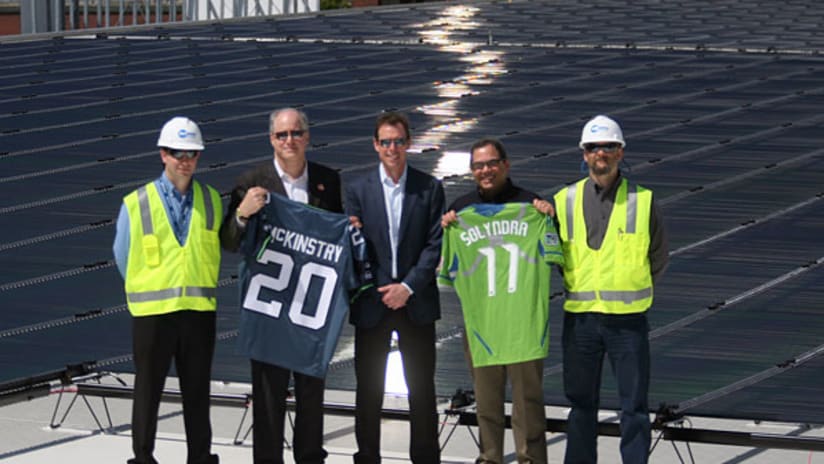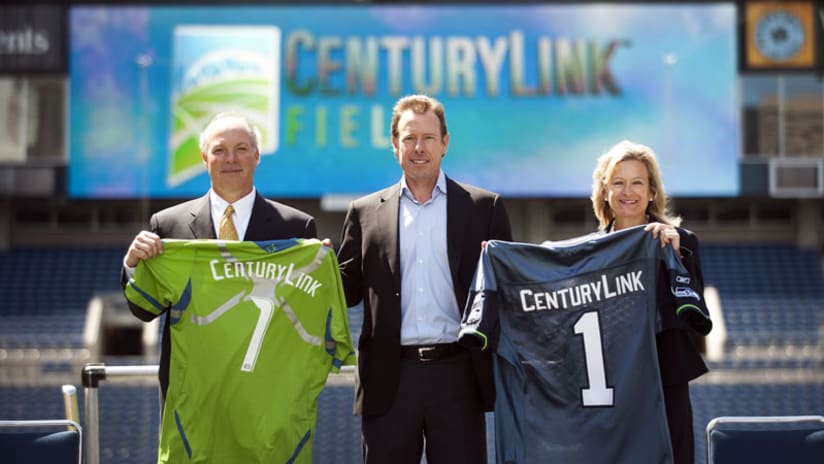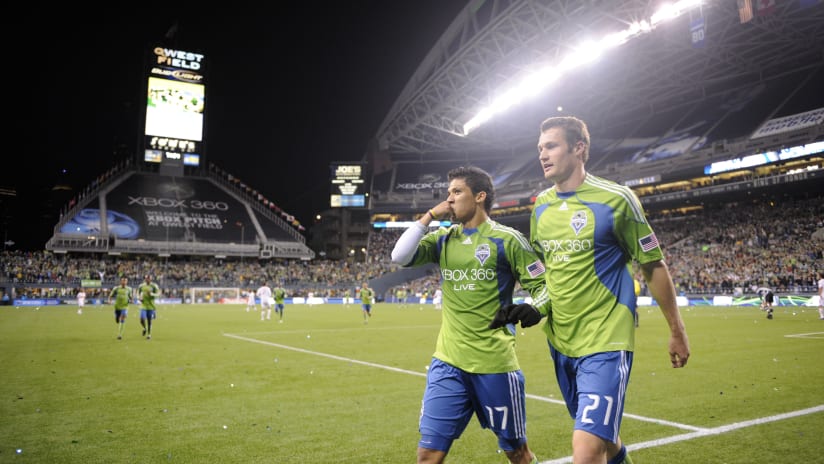Qwest Field, home of the Seahawks and Sounders FC, is turning sunshine into electricity with the installation of 3,750 solar panels on the roof of the Event Center.
Read Press Release
It’s not easy being green.
Just ask Kermit the Frog. Better yet, ask Peter McLoughlin, president of the Seahawks, SoundersFC and First & Goal Inc.; Dean Allen, CEO of McKinstry, a Seattle-based design-build firm that specializes in energy solutions; and Ben Bierman, executive vice president of operations and engineering for Solyndra.
This think-green trio joined forces Tuesday to announce the installation of 3,750 solar panels on the roof of the Qwest Field Event Center.
While Solyndra developed the glass-rod technology used in the panels and McKinstry is installing them, it is the Seahawks and SoundersFC who have been pushing to turn what was a vast – and unused – roof area into an innovative energy-supplying system.
“What a perfect spot for it,” McLoughlin said. “It’s the right thing for the environment. It’s the right thing for energy conservation. And it’s going to save us money in the long run.
“It’s really smart. It’s just the right thing to do.”
The obvious question: Why wasn’t this done sooner? Like in 2002, when the stadium opened?
The technology that is the glass rods was not developed until 2008. That’s significant, because the rods are lighter and generate more energy than the large solar panels. They’re also easier to install and maintain.
“It’s unique in that there’s no penetration needed to anchor the panels,” Allen said. “The weight of the system and the way it’s tied together is what actually holds it down. One of the big problems with a lot of our solar installation on flat roofs is you end up putting thousands of holes into the roof and the next thing you know you’ve got a lot of leaks to deal with.”
Lighter and more efficient, yet still strong and durable. The panels have been tested to withstand 130 mph winds and hail the size of golf balls.
“It’s a technology whose time has come,” Allen said.
One that will slice the utility costs at Qwest by 21 percent (or $280,000), while also reducing carbon emissions (by 1,346 metric tons) and saving on water (by 1,342,660 gallons). The system will generate 830,000 kWh of electricity annual, which is the equivalent of powering 95 homes in the Seattle area.
“The product was developed from 2005-2008, and very, very quickly brought to market,” Bierman said. “From 2008 on, we’ve been selling them. We’ll ship our one millionth panel this week.”
The on-going project on the roof of the Event Center is the largest solar-panel installation venture on the West Coast. It’s fitting, because it matches the continued commitment to being green by the Seahawks and SoundersFC – championed by owner Paul Allen and Jody Allen, president and CEO of Vulcan Inc.
“Seeing the stadium from my office got me thinking about how we could use roof space to add a solar array,” Paul Allen said in a statement. “I’m thrilled that with this new project we can now add green energy production to reduce the building’s carbon footprint and contribute to Washington State’s renewable energy goals.”
One step led to another, and then another, as green got greener.
“When this building was constructed in 2002, Paul and Jody all along wanted it to be environmentally efficient and friendly to save resources and energy,” McLoughlin said. “So in a continuation of that belief, we reached out to McKinstry and said, ‘What more can we do to do things better?’ They came back with this overall plan to our continued commitment.”
Continued commitment? In 2010 at Qwest Field, 525 tons of waste was recycled.
The solar panels are just the next step.
“It’s the right mentality and the right mindset,” McLoughlin said. “It’s something everybody in the country needs to embrace, and I’m glad we do it here.”
So while it’s not easy being green, it is prudent.




